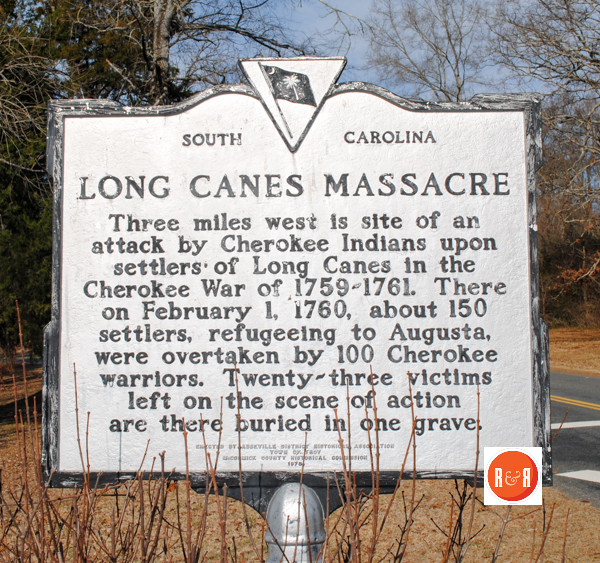Calhoun Family Genealogy
City Directories and History: The history of the Indian Massacre at Long Cane’s community………..
The Long Cane Massacre Site is significant to the history of exploration and settlement in South Carolina and for its  association with the Cherokee War of 1760-61 and the Calhoun settlement of Long Cane. The property includes the gravestone which marks the place where twenty-three of the Long Cane settlers were killed in a bloody massacre by the Cherokee Indians on February 1, 1760. Among those killed was Catherine Calhoun, matriarch of the Calhoun
association with the Cherokee War of 1760-61 and the Calhoun settlement of Long Cane. The property includes the gravestone which marks the place where twenty-three of the Long Cane settlers were killed in a bloody massacre by the Cherokee Indians on February 1, 1760. Among those killed was Catherine Calhoun, matriarch of the Calhoun  family, who figured prominently in the settlement of upcountry South Carolina. Long Cane Massacre can be attributed in part to a boundary dispute between the Cherokee Indians and white settlers over a parcel of land lying between Long Cane Creek and Little River. The site is located in a secluded area, contributing to the preservation of the site’s historic integrity. A small metal footbridge, built ca. 1945, spans a small stream near the gravestone. Listed in the National Register January 27, 1983. ( Courtesy of South Carolina Department of History and Archives)
family, who figured prominently in the settlement of upcountry South Carolina. Long Cane Massacre can be attributed in part to a boundary dispute between the Cherokee Indians and white settlers over a parcel of land lying between Long Cane Creek and Little River. The site is located in a secluded area, contributing to the preservation of the site’s historic integrity. A small metal footbridge, built ca. 1945, spans a small stream near the gravestone. Listed in the National Register January 27, 1983. ( Courtesy of South Carolina Department of History and Archives)
Another National Register entry from McCormick County — the Long Cane Massacre site — reflects history even earlier than the French Huguenot settlement. Located in a rural area of northern McCormick County, the site is significant to the history of exploration and settlement of the upcountry, especially for its association with the Cherokee War of 1760-61, and the settlement at Long Cane of the Calhoun family, who arrived in South Carolina from Augusta County, Virginia, in 1756, locating west of Long Cane Creek in order to take advantage of the especially rich soil between Long Cane to the east and Little River to the west. The nominated properly includes the gravestone which marks the place where twenty-three of the Long Cane settlers were killed in a bloody massacre by the Cherokee Indians on February 1, 1760. Among those killed was Catherine Calhoun, matriarch of the Calhoun family, aged 76 years. The rough hewn stone was placed at the site by Patrick Calhoun, in memory of his mother. (Information from: Names in South Carolina by C.H. Neuffer, Published by the S.C. Dept. of English, USC)
Stay Connected
Explore history, houses, and stories across S.C. Your membership provides you with updates on regional topics, information on historic research, preservation, and monthly feature articles. But remember R&R wants to hear from you and assist in preserving your own family genealogy and memorabilia.
Visit the Southern Queries – Forum to receive assistance in answering questions, discuss genealogy, and enjoy exploring preservation topics with other members. Also listed are several history and genealogical researchers for hire.
User comments welcome — post at the bottom of this page.
Please enjoy this structure and all those listed in Roots and Recall. But remember each is private property. So view them from a distance or from a public area such as the sidewalk or public road.
Do you have information to share and preserve? Family, school, church, or other older photos and stories are welcome. Send them digitally through the “Share Your Story” link, so they too might be posted on Roots and Recall.
Thanks!
Calhouns of Long Canes Information from: Greenwood County Sketches by Margaret Watson, 1982
It seems safe to say that Calhouns were the most numerous and among the most prominent of the earliest known settlers in this part of South Carolina. Coming in 1756 to settle in the “Long Canes,” about 20 miles southwest of Ninety Six, were four brothers, James, William, Ezekiel and Patrick Calhoun, their families, their widowed mother, Mrs. Catherine Calhoun, and their sister, Mrs. Mary Catherine Calhoun Noble, widow of John Noble. There were still more Calhouns in the Long Canes settlement as indicated by land grants, tax returns and other documents, but their relationships with the four brothers have not been established.
Frequent use of the same given names compounds the difficulty of keeping track of the Calhouns. For example, there were at one time, six different Patrick Calhouns and six different William Calhouns living in the Long Canes section.
The original Long Canes settlement was not far from the present community of Mount Carmel in McCormick County. Greenwood has no claim on these pioneer Calhouns, except through the descendants, listed below, but the Patrick Calhoun who came with his brothers in 1756 was a leader and official in the original Ninety Six District and figures in the district’s story.
Size of the settlement of Calhouns and other families is shown by the report that there were more than 100 men, women and children leaving their homes in the Long Canes Feb. 1, 1760 because of an expected Indian attack. In wagons, on horseback and on foot, the party was headed for Augusta, but was ambushed near Long Cane Creek that night. At least 23 were killed by the Indians, including Mrs. Catherine Calhoun and several in her family. A marker to his mother and other victims of the Long Cane massacre was erected some years later by Patrick Calhoun at the site, not far from Troy.
Patrick Calhoun was a deputy surveyor for the province and his name appears on many plats. He was designated by authorities in Charles Town to help with the settlement of French Huguenots at New Bordeaux in 1764 and with the German colony at Londonborough in 1765. He was the first Upcountry member of the Commons House of Assembly, elected in 1769. Patrick and his brother William Calhoun were justices of the peace for Granville County, which began at the coast and extended inland along Savannah River for several hundred miles. After Ninety Six District was established, the brothers were justices of the peace in the district, and Patrick Calhoun also was first surrogate in the court of ordinary Qudge of probate) for the new district. He had been an outspoken advocate for creation of the district and for government consideration of Upcountry needs.
Patrick Calhoun, 1727-1796, was twice married, first to Jane Craighead who died in 1766, no record of children, and second to Martha Caldwell*, 1750-1802. They had five children. Their fourth child was John Caldwell Calhoun, South Carolina’s notable statesman.
Youngest child of Patrick and Martha Caldwell Calhoun was Patrick Calhoun, Jr., who married Nancy Needham de Graffenreid, six children, one of whom was Ludlow Calhoun who married Margaret Teague, 11 children. Ella Calhoun, youngest child of Ludlow and Margaret Teague Calhoun, married Sampson B. Mays of Edgefield, eight children, including Calhoun A. Mays, Mrs. Eugene H. Blake, Miss Ella Mays and Mrs. D.G. Gambrell, all of Greenwood.
User comments always welcome - please post at the bottom of this page.






Share Your Comments & Feedback: